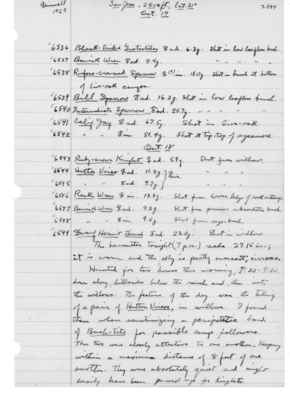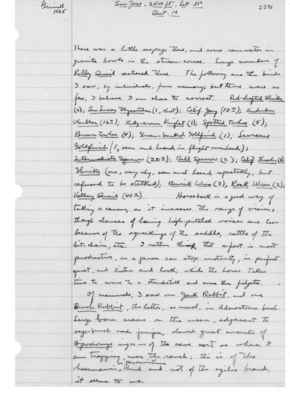Pages That Mention Ruby-crown Kinglet
1925: Joseph Grinnell's field notes
S3 Page 51
Collector: Grinnell - 1925 Location: San Jose, 2500 ft., Lat. 31 degrees Date: Oct. 17 Page Number: 2594
6536 Black-Tailed Gnatcatcher (female sign) ad. 6.3g. Shot in low leafless bush. 6537 Bewick Wren (male sign) ad. 8.4.g. 6538 Rufous-crowned Sparrow (male sign)(?) im. 18.0g. Shot in bush at bottom of Live-oak canyon. 6539 Bell Sparrow (male sign) ad. 16.2g. Shot in low leafless brush. 6540 Intermediate Sparrow (male sign) ad. 25.7. Shot in low leafless brush. 6541 Calif. Jay (female sign) ad. 67.5g. Shot in live-oak. 6542 “ “ (male sign) im. 81.4 g. Shot at tip-top of sycamore.
Oct. 18 6543 Ruby-crown Kinglet (female sign) ad. 5.9g. Shot from willow. 6544 Hutton's Vireo (female sign) ad. 11.2g. } Pair “ “ “ 6545 “ “ (male sign) ad. 9.7 g. } Pair “ “ “ 6546 Rock Wren (female sign) im. 13.8g. Shot from lower ledge of rock outcrop. 6547 Bewick Wren (female sign) ad. 9.2g. Shot from prunus subcordata bush. 6548 “ “ (male sign) im. 9.5g. Shot from sage-bush. 6549 Dwarf Hermit Thrush (male sign) ad. 23.0g. Shot in willow.
The barometer tonight (7 p.m.) reads 27.15 in.; it is warm and the sky is partly overcast, cirrous.
Hunted for two hours this morning, 7:30-9:30, down along hillsides below the ranch and then into the willows. The feature of the day was the taking of a pair of Hutton's Vireo, in willows. I found them when scrutinizing a peripatetic band of Bush-tits for possible camp followers. The two were closely attentive to one another, keeping within a maximum distance of 8 feet of one another. They were absolutely quiet and might easily have been passed up for Kinglets.
S3 Page 53
Collector: Grinnell - 1925 Location: San Jose, 2500 ft., Lat. 31 degrees Date: October 19, 1925 Page Number: 2596
There was a little seepage there, and some rainwater in granite bowls in the stream-course. Large numbers of Valley Quail centered there. The following are the birds I saw, by individuals, from memory; but there were so few, I believe I am close & correct. Red-shafted Flicker (2); San Lucas Flycatcher (1, shot); Calif Jay (10±) Audubon Warbler (16±); Ruby-crown Kinglet (1); Spotted Towhee (5); Brown Towhee (4); Green-backed Goldfinch (1); Lawrence Goldfinch (1, seen and heard in flight overhead); Intermediate Sparrow (20±); Bell Sparrow (2); Calif. Thrashers (3); Shrike (one, very shy, seen and heard repeatedly, but refused to be stalked); Bewick Wren (3); Rock Wren (2); Valley Quail (40±). Horseback is a good way of taking a census, as it increases the range of vision, though chances of hearing high-pitched voices are less because of the squeakings of the saddle, rattle of the bit-chain, etc. I rather think that a foot in most productive, as a person can stop instantly, in perfect quiet, and listen and look; while the horse takes time to come to a standstill and even then fidgets. Of mammals, I saw one Jack Rabbit, and one Bush Rabbit, the latter, as usual in Adenostoma bush. Large bare areas in the mesa, adjacent to sage-bush and juniper, showed great amounts of Dipodomys sign — of the same sort as where I am trapping, near the ranch; this is of the heermanni or paramintinus kind and not of the agilis brand, it seems to me.

